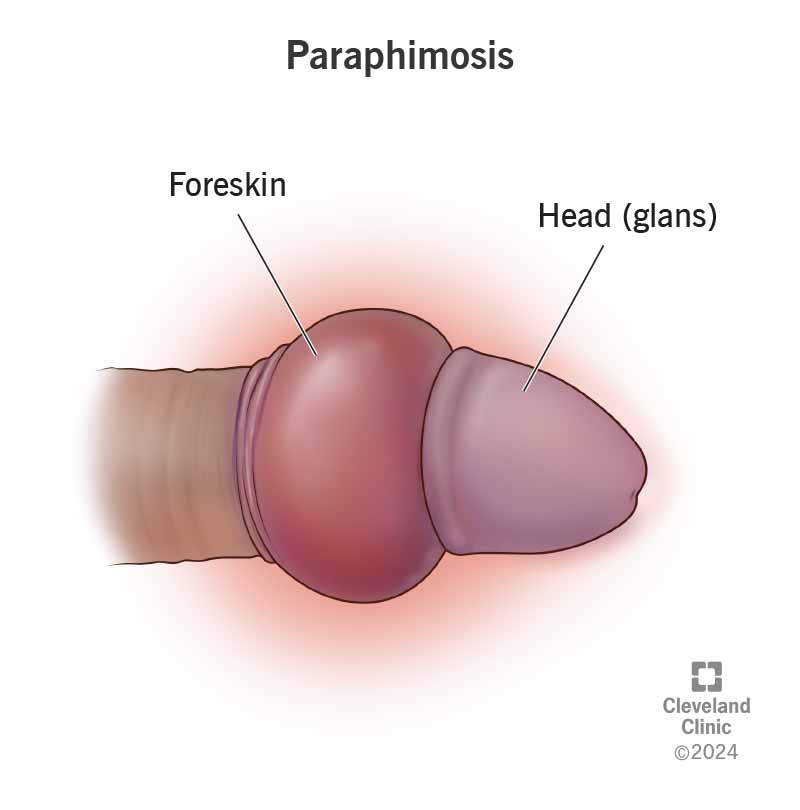Paraphimosis is a medical emergency in which you can’t draw your foreskin back down over the head of your penis. It can happen if you have a partially circumcised or uncircumcised penis. You must get treatment as soon as possible to prevent permanent damage to your penis.
Advertisement
Cleveland Clinic is a non-profit academic medical center. Advertising on our site helps support our mission. We do not endorse non-Cleveland Clinic products or services. Policy

Paraphimosis is a painful condition that causes your foreskin to become trapped behind the head (glans) of your penis. If you have paraphimosis, you can’t pull your foreskin down to cover the end of your penis. It can cut off the delivery of blood and oxygen (circulation) to the tip of your penis.
Advertisement
Cleveland Clinic is a non-profit academic medical center. Advertising on our site helps support our mission. We do not endorse non-Cleveland Clinic products or services. Policy
Paraphimosis is a medical emergency. If you have symptoms of paraphimosis, get medical help immediately.
Paraphimosis is rare. About 0.2% of uncircumcised children between 4 months and 12 years old will have paraphimosis. Circumcision is a procedure that removes the foreskin, which usually occurs shortly after birth.
For uncircumcised males 16 and older, the rate of paraphimosis rises to 1%. This is still rarer than other penile disorders that can affect your foreskin, including:
The main symptom of paraphimosis is you can’t pull your foreskin forward into its proper place over the tip of your penis (foreskin reduction).
Other paraphimosis symptoms include:
Paraphimosis often happens when you pull back your foreskin to clean under it or if you’re trying to stretch your foreskin because it’s too tight. It can also happen during certain medical procedures in which a healthcare provider has to move your foreskin, like catheterization.
Other paraphimosis causes may include:
Advertisement
Paraphimosis affects people who have partially circumcised or completely uncircumcised penises.
Without immediate medical treatment, paraphimosis may:
Paraphimosis symptoms are typically obvious. You’ll likely notice swelling or discomfort in your penis. A healthcare provider can diagnose paraphimosis after reviewing your symptoms and examining your penis.
Paraphimosis is an emergency. So, when you contact a provider and describe your symptoms, they’ll likely tell you to go to the emergency room right away for treatment.
To treat paraphimosis, a healthcare provider may recommend treatments like:
If you’ve had paraphimosis, it’s likely to come back (recur). A provider may suggest removing some or all of your foreskin. If you aren’t a good candidate for circumcision, a dorsal slit will prevent paraphimosis from coming back.
Although ice can reduce swelling, it’s not the best way to treat paraphimosis. It can make your blood flow worse.
No, paraphimosis can’t go away on its own. You must get medical treatment as quickly as possible to treat paraphimosis.
Circumcision and dorsal slit are safe procedures. But every type of surgery has risks. Potential circumcision and dorsal slit risks include:
With quick, proper treatment, the outlook for paraphimosis is very good. But if you can’t put your foreskin back into position by yourself after treatment, you run the risk of getting paraphimosis again. That’s why healthcare providers usually suggest circumcision.
Circumcision is the only way to completely prevent paraphimosis. But if you have foreskin, you can help prevent paraphimosis by:
Advertisement
Contact a healthcare provider as soon as possible if you can’t move your foreskin back into place. You’ll likely need to see a provider right away or go to the nearest emergency room for treatment.
If you still have your foreskin after treatment, there’s a good chance that paraphimosis can come back. Reach out to a provider quickly if your symptoms return.
If your paraphimosis treatment requires circumcision, call a provider if:
You may want to ask your provider:
In children, you usually can’t pull the foreskin back until they’re at least 5 years old. But sometimes, they may not be able to pull it back until they’re 10 or until their teenage years.
Once you can retract your foreskin, it’s important to clean underneath it to prevent oil, dead skin cells, sweat and other fluids (smegma) from building up. Cleaning also helps prevent inflammation from developing on your penis, including your:
Advertisement
Paraphimosis and phimosis are both conditions that affect your foreskin. But paraphimosis is a medical emergency. Phimosis isn’t.
Phimosis can happen when you have an uncircumcised or partially circumcised penis. You can’t pull the foreskin back to reveal the head of your penis. Babies have phimosis at birth, and their foreskin usually loosens as they get older. But you may develop phimosis from infections (including sexually transmitted infections) or scarring.
Phimosis treatment usually involves applying a corticosteroid cream or gel to your penis or antibiotics if you have an infection. If those don’t work, you may need a circumcision.
You can’t fix paraphimosis at home. Get medical help as soon as you can if you have paraphimosis symptoms.
Paraphimosis requires immediate medical treatment to prevent permanent damage to your penis. You may think it’ll go away if you rest or ice your penis. But any time you have a lot of pain or you can’t pull your foreskin down like normal, your body’s telling you that something is wrong. Getting medical attention as soon as possible is very important to ensuring that you don’t have lasting damage.
Advertisement
Whether you need stitches, a broken bone set or think your appendix might be causing your abdominal pain, Cleveland Clinic’s emergency medicine team is here to help.

Last reviewed on 03/19/2025.
Learn more about the Health Library and our editorial process.